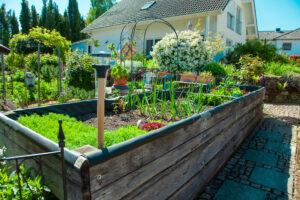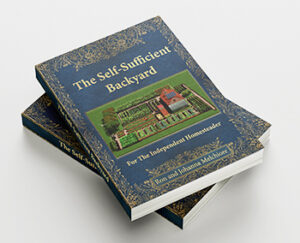Introduction: What is Permaculture?
Permaculture is an ecological design system for sustainable living. It draws from multiple disciplines such as the sciences, ecology, and traditional knowledge to create self-regulating systems that mimic natural patterns in order to meet human needs. Permaculture combines the principles of conservation and regeneration, using renewable resources wisely, as well as utilizing strategies like crop rotation, companion planting, and water management. It’s a holistic approach to land use that focuses on creating an ecologically sound, self-sufficient systems as opposed to monocropping whose main interest is maximum production for a profit but often at the cost of soil helth and food quality. In this article we will talk about how to start a permaculture garden.
Benefits of Permaculture Gardening
Permaculture gardening offers many benefits for both people and the environment. By utilizing natural processes like crop rotation, companion planting, and harvesting rainwater, permaculture gardens can be incredibly productive and require fewer inputs and less labor. They are also great for the environment, as they help to conserve water, reduce soil erosion, build soil fertility, sequester carbon dioxide from the atmosphere, and increase biodiversity. In addition to these ecological benefits, permaculture gardening offers numerous economic and health benefits as well such as improved quality of food and decreased grocery bills, not to mention the more societal benefits of not needing to transport as much food.

Preparing the Space for Planting
Before planting a permaculture garden, there are several steps that need to be taken to ensure the success of the system and safeguard against potential problems. One of the most important steps is creating the right soil environment for plants. This involves testing soil pH and nutrient levels, improving water retention, regulating temperature, and adding organic matter. The basis of permaculture is soil health. Commercial monocropping destroys the earth it grow in requiring more and more inputs to be successful and resulting in less and less fertile soil. Preparing the space also involves choosing the right location for your garden, ensuring adequate drainage systems are in place, and selecting appropriate plants for the climate and soil conditions.

A. Selecting the Right Location
When selecting a location for your permaculture garden, it’s important to consider the temperature, sunlight levels, and soil fertility. Look for a spot that’s well-drained and has at least six hours of sun exposure each day—this will provide ample light for plants to thrive.
B. Planning Out Your Garden Layout
Planning the layout of your permaculture garden before planting is essential to its success. It’s important to identify and prioritize the needs of the plants, the ecosystem, and the people who will be using it. Consider which plants should be situated in which areas; for example taller plants behind shorter ones so they won’t shade out the smaller plants. Additionally, make sure to plan for enough space between plants that they will not be crowed in a fully grown state and pathways where people can move comfortably.
You can also consider incorporating companion planting in your permaculture garden. This involves strategically placing plants together that complement each other by providing beneficial nutrients, protection from pests or disease, or increasing pollination. When considering companion planting, it’s important to research the which plants have similar growing conditions and provide benefit to each other.

Building Fertile Soil

Creating fertile soil is the single most important issue for a successful permaculture garden. This involves testing soil pH and nutrient levels, improving water retention, regulating temperature, and adding organic matter. Adding compost is also a great way to introduce beneficial microorganisms into the soil, creating a healthier environment for your plants. In permaculture everything is used. Spent plants are composted. The compost is then returned to the garden beds. In monoculture cropping this is achieved by using large mounts of chemical fertilizer and pesticides that then seep into the ground water and food supply poisoning both.
Testing soil pH and nutrient levels
Testing soil pH and nutrient levels is an important step in creating a successful permaculture garden. The ideal pH level should fall between 6 and 7.5; if the pH is too low or too high, it can decrease the availability of certain nutrients to the plants and hinder their growth. Additionally, it’s important to test for nitrogen, phosphorus, and potassium levels to ensure the soil is nutrient-rich and can support healthy plant growth. The difference here is permaculture uses natural methods to achieve this. Instead of chemicals more organic methods such as compost, blood meal, bone meal, fish emulsion and cover cropping.
Improving water retention in the soil
Improving water retention in the soil is also important for a successful permaculture garden. The addition of organic matter such as compost or mulch will help retain moisture and prevent erosion while allowing oxygen to reach deeper into the soil. Additionally, adding loose soil around the base of plants can help them absorb more water. Using mulch around your plants can also increase water retention
Regulating temperature
Regulating temperature is also key to creating a successful permaculture garden. Installing shade structures or using mulch or other organic matter can help keep the soil cooler on hot days and prevent it from becoming too dry. Additionally, planting trees, shrubs, and other foliage can provide natural shade and help control temperatures in your permaculture garden. Mulch can also help in both temperature regulation and water retention. Interplanting and companion planting is a big part of permaculture and deserves it’s own article,
Choosing appropriate plants
Choosing appropriate plants that are well-suited to your climate is essential for creating a successful permaculture garden. Researching plants that will do well in your area, and understanding their water needs and preferences, will ensure you create an environment where they can thrive. Additionally, planting a variety of flora will help attract beneficial insects and pollinators. In a permaculture garden you don’t plant things that take too many resources to grow such as citrus in zone’s it can’t grow in without a greenhouse. You look at what nature in your area volunteers as a substitute. This would be plants that already grow easily in your area.
Water Retention
Water retention in the context of this article on gardening is a key component of permaculture gardening, as it ensures that plants have access to the moisture they need to grow and thrive. Adding organic matter such as compost or mulch can help retain moisture in the soil and prevent erosion. Additionally, loose soil around the base of plants will help them absorb more water. Installing shade structures or using other organic matter can help regulate the temperature of the soil, ensuring that it doesn’t become too dry on hot days. Planting a variety of foliage and researching plants suited to your climate will also help create an environment where they have access to the moisture they need. By implementing these techniques, you can ensure that your permaculture garden has adequate water retention for healthy and abundant growth.
Organic matter
Organic matter is essential to creating a successful permaculture garden, as it helps improve the soil structure and increases nutrient availability, while also providing food for beneficial microorganisms. Using organic matter like compost, mulch, or manure can also help regulate water retention and increase the water-holding capacity of the soil. Adding organic matter to the soil can help increase fertility. This is why composting is so important in any permaculture garden as it provides fertility and it avoid waste. For more about composting check my articles here.
Compost
Compost is an excellent way to introduce beneficial microorganisms into a permaculture garden. Compost is created when organic materials such as plant and animal matter are broken down by bacteria, fungi, and other microorganisms. Adding compost to your garden encourages the growth of these beneficial organisms which help convert organic material into nutrients that can be used by your plants.
Mulching and Leaf Mold
Mulching and leaf mold are excellent methods of amending the soil in a permaculture garden. Mulch is organic material, such as wood chips, straw or leaves, which is applied to the soil surface to retain moisture and prevent weeds from sprouting. Leaf mold is made up of decomposed leaves that provide important nutrients and beneficial
Cover crops
Cover crops are an essential part of a successful permaculture garden. Cover crops help improve soil fertility by adding nutrients and organic matter to the soil, and they can also help reduce erosion from wind and rain, as well as prevent weeds from taking over your garden. Cover crops such as clover, rye, and fescue help to increase the nutrient availability of the soil by breaking down organic matter and releasing essential plant nutrients into the soil. Additionally, these cover crops can fix nitrogen back into the soil through their root systems which helps to promote plant growth. The added organic matter also helps improve water retention.
Planting Your Garden
Once the soil is prepared and the layout planned, it’s time to start planting! When selecting plants, make sure you read up on their needs and choose varieties that will thrive in your climate. Make sure to pay attention to spacing and light requirements; for example, sun-loving plants should be placed in an area that gets ample sunlight throughout the day. In permaculture, things are not planted in rows. Rather, the concept of guilds is used. An example is intercropping orchards with plants that can benefit the fruit tree and provide biomass for compost or perhaps feed for animals. On a smaller scale, you might surround your apple tree with plants that repel pests like mint but could also be used for tea, or even flowers like daffodils that repel deer and voles and provide beauty. Permaculture attempt to mimic nature in which there are very few lines and everything grows in a relationship.
Permaculture gardens are also designed with an emphasis on using the resources available in the local environment to create a productive and resilient ecosystem. This includes taking advantage of natural windbreaks, mulching with native materials, utilizing organic waste from the garden, planting varieties that are well suited to your area. Permaculture gardens tend to use no dig methods focused on building soil fertility over time.
Example of possible Permaculture Garden Planting Area
My first no dig bed build using permaculture in my urban yard was built using the following steps:
- Lay a 6 sheet layer of newsprint or packing paper over the area you want to plant overlapping edges about 6 inches
- Over this put tape and label free cardboard also overlapping cardboard about 6 inches
- Soak this with water
- If you are worried about moles or voles you can put a layer of chicken wire down as well.
- This will serve to smother the underlying grass and as the material breaks down it attracts worms who love cardboard.
- Cover this with a nice layer of hay. Preferably organic. I actually just used straw as they had no hay and it worked fine
- Now sprinkle over the hay bloodmeal and bone meal
- On top of this put a layer of compost about 3-4 inches.
- Repeat the straw, bonemeal, bloodmeal and compost again soaking with water between steps
- Top this off with a good quality, well draining garden soil about three inches
- You can plant in this immediately
- In the beginning it will be a rather tall bed but this will break down into wonderful soil full of worms over time and settle.
- Each year repeat a layer of straw, bonemeal, bloodmeal and compost to replenish the soil.
- Do this in the fall and it will be ready to plant by spring.
I’ve seen this method done on grass and even concrete! You can do it as a raised bed or just on the ground with no container. I keep my beds to 4 foot wide and however long is doable. This allows them to be easy to work from each side. Allow for 2 or 3 foot paths between beds. You will place cardboard or landscaping fabric over the walking paths and cover with woodchips, gravel or even sand and pavers.
Start with one small area of your lawn and make just one bed using this method. Rinse and repeat until you have covered all that unproductive lawn grass with food and herb producing gardens.
This is an affiliate link.

Water Use and Drainage in Permaculture
Water use and drainage in permaculture is an important part of creating a sustainable, resilient ecosystem. Permaculture gardening techniques take into account the local climate and rainfall patterns to maximize water efficiency. By incorporating swales, which are shallow ditches running along the contour of the land that capture and direct runoff, more water can be absorbed and stored in the soil, reducing runoff and preventing soil erosion. To further conserve water, permaculture gardens are often designed with raised beds or mounds to reduce evaporation and allow for efficient water absorption. They also make use of run off from buildings with gutter’s and rain barrels. In larger operations they may have collection ponds to catch drain off from higher elevations that are then tapped to water area below them, often only using gravity. To read more about rainwater harvesting check my article.
Mulching is an important part of protecting the soil and preserving moisture, as well as reducing weeds. Composting with organic matter adds additional nutrients to the soil while also creating habitat for beneficial insects and other wildlife in your garden.
Dealing with Pest and Disease
Companion planting is a key permaculture technique that can help deal with pest and disease. By planting certain species together, you can benefit from natural pest control, increased yields, and improved soil fertility. Some popular companion planting combinations include tomatoes and basil, carrots and onions, squash and corn, and beans and peas.
Attracting beneficial insects to your permaculture garden is an excellent way to naturally deter pests while also helping to pollinate plants. To do this, plant flowers such as marigolds, dill, and yarrow around the perimeter of your garden. Additionally, you can also create habitats for beneficial insects such as bee houses or bug hotels.
Organic pesticide solutions, such as neem oil or garlic sprays, can be a great way to control pests in your permaculture garden. Neem oil works by disrupting the growth hormones of pest insects and prevents them from laying eggs. Garlic spray is made up of minced garlic and water and can be used to repel aphids, spider mites, and other pests. Before applying either of these solutions, be sure to read the instructions carefully and test it on a small area first. Additionally, always wear protective clothing when handling pesticides. Lastly, avoid spraying during windy or hot weather as this can damage your plants.
In addition to companion planting, attracting beneficial insects, and using organic pesticides, you can also use crop rotation in your permaculture garden to help reduce the risk of disease. Crop rotation is the practice of growing different crops in a specific area over consecutive years, rather than replanting the same crop in the same place. By rotating crops, you can help break the life cycle of pests and reduce pest problems. Additionally, crop rotation also prevents nutrient depletion in the soil and helps to improve fertility.
Conclusion:
In conclusion, permaculture focuses on finding societal answers to our broken food system and the damage so called modern agriculture is doing to both the soil and our food. Having a permaculture garden in your yard instead of monoculture lawns is a great way to grow your own food and be a small part of the solution to a growing issue in an eco-friendly and sustainable manner. By replacing part or all of your lawn with a permaculture garden and implementing companion planting, attracting beneficial insects, using organic pesticides, and practicing crop rotation in your permaculture garden, you can help reduce pest infestations while also protecting the health of your plants and increase your food health and the soil health of your small corner of the world. With proper planning and maintenance, you can have a thriving permaculture garden that will provide you with nutritious and delicious produce for years to come. In the end, all the world is made up of our various small corners and if we all decided to do our small part a big difference could be made.
